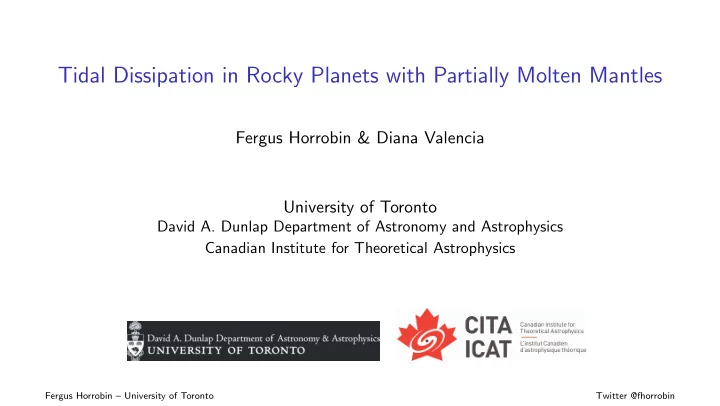

Tidal Dissipation in Rocky Planets with Partially Molten Mantles Fergus Horrobin & Diana Valencia University of Toronto David A. Dunlap Department of Astronomy and Astrophysics Canadian Institute for Theoretical Astrophysics Fergus Horrobin – University of Toronto Twitter @fhorrobin
Overview 1. Describe tidal dissipation using examples from solar system and exoplanets 2. Present interior model and numerical method 3. Discuss effect of melt production on dissipation 4. Present applications to Io and Trappist-1b 5. Discuss flow of melt through crust in earth-like bodies Fergus Horrobin – University of Toronto Twitter @fhorrobin
Tidal Dissipation ◮ Body deforms due to changes in tidal force ◮ Rigidity of material resists deformation ◮ Thermal energy dissipated from internal friction Fergus Horrobin – University of Toronto Twitter @fhorrobin
Why is Tidal Dissipation Important Dynamics : dissipated energy is taken from orbital energy (e.g., Murray+ 2000). Can cause migration, change eccentricity. For example: Titan. Fergus Horrobin – University of Toronto Twitter @fhorrobin
Why is Tidal Dissipation Important Interiors : dissipation is released as thermal energy which affects convection and melt in mantle. Can increase geological activity. For example: Io Fergus Horrobin – University of Toronto Twitter @fhorrobin
Why is Tidal Dissipation Important Habitability : heat can transport to surface and affect surface temperatures, atmospheres (e.g., Valencia+ 2018). For example: Trappist-1 Fergus Horrobin – University of Toronto Twitter @fhorrobin
Interior Modelling and Computing Dissipation ◮ From values of M , R compute material model (Valencia 2007) Crust ◮ Solve for continuous ρ ( r ) , T ( r ) , p ( r ) in each region ◮ Material type, ρ , p and T specify Mantle η, G , K ◮ Steady state dissipation, potential averaged throughout orbit Outer Core ◮ 3D Spherical grid: ∼ (80 × 150 × 75) ◮ Propagator matrix method adapted Inner Core from TiRADE (Roberts & Nimmo 2008) Fergus Horrobin – University of Toronto Twitter @fhorrobin
Temperature Profile and Melt ◮ Iteratively alternate solving for dissipation then heat equation, melt ◮ Temperature profile from adiabatic potential mantle, conductive crust ◮ Melting curve from e.g, Gonzalez-Cataldo (2006) ◮ Melt transport based on Darcy’s law (Moore 2001) ◮ Volumetric melt fraction ( φ ) directly changes the strength of the material (e.g., Mei 2002) G o G ∼ η ∼ η o exp ( αφ ) 1 + c φ ◮ Dissipation = ⇒ melt = ⇒ dissipation (initially) increases ◮ Melt becomes large makes dissipation less efficient, reaches equilibrium Fergus Horrobin – University of Toronto Twitter @fhorrobin
Io: An Example Calculation Figure: Solid line shows results without melt feedback, dashed line includes melting Fergus Horrobin – University of Toronto Twitter @fhorrobin
Io: Comparison with Other Works and Observations ◮ Not novel, but good for benchmarking ◮ Total heat output used as one example of constraint ◮ D T ≈ 9 . 12 × 10 4 GW ◮ Good agreement with Bierson & Nimmo (2016) (9 . 82 × 10 4 GW ) ◮ Other works which found similar results with different/simpler models include Moore (2003) ( ∼ 2 × 10 4 GW ), Clausen & Tilgner (2015) ( ∼ 1 . 1 × 10 5 GW ). ◮ Compatible with observed value 0 . 6 − 1 . 6 × 10 5 GW (e.g., Moore et. al. 2007) Fergus Horrobin – University of Toronto Twitter @fhorrobin
Trappist-1b Figure: Solid line shows results without melt feedback, dashed line includes melting. Comparison see: Dobos et. al (2010). Fergus Horrobin – University of Toronto Twitter @fhorrobin
Melt Flow Through Crust - Intrusive Melt Figure: f measures efficiency of melt percolation through crust. 1 . 0 → Darcy flow continues through crust, 0 . 3 → some melt trapped by rigid crust. (e.g., Tackley 2000) Fergus Horrobin – University of Toronto Twitter @fhorrobin
Conclusions ◮ Dissipation structure and amount depend on the melt fraction ◮ Melt fraction depends on amount and localization of dissipation ◮ Feedback between them occurs, treating rheology well is important ◮ We combine high resolution models of rheology, dissipation and mantle melt ◮ Still lots of constraints need to be made to create accurate model ◮ Discussing dissipation in an accurate way necessitates bringing geophysical knowledge into planetary astronomy Fergus Horrobin – University of Toronto Twitter @fhorrobin
Recommend
More recommend